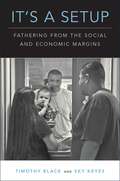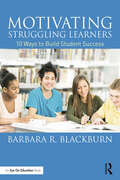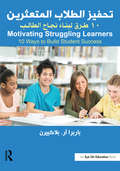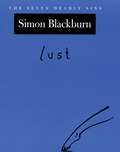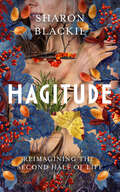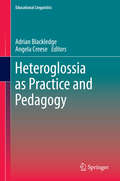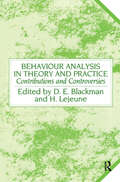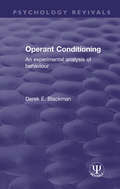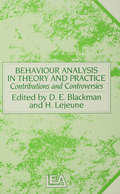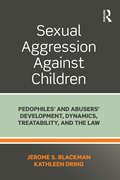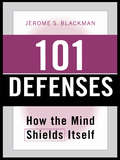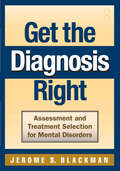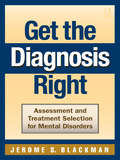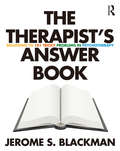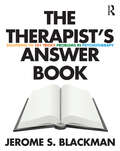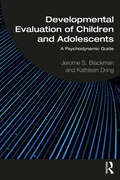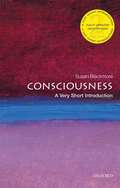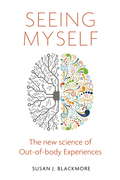- Table View
- List View
It's a Setup: Fathering from the Social and Economic Margins
by Timothy Black Sky KeyesThe expectation for fathers to be more involved with parenting their children and pitching in at home are higher than ever, yet broad social, political, and economic changes have made it more difficult for low-income men to be fathers. In It's a Setup, Timothy Black and Sky Keyes ground a moving and intimate narrative in the political and economic circumstances that shape the lives of low-income fathers. Based on 138 life history interviews, they expose the contradiction that while the norms and expectations of father involvement have changed rapidly within a generation, labor force and state support for fathering on the margins has deteriorated. Tracking these life histories, they move us through the lived experiences of job precarity, welfare cuts, punitive child support courts, public housing neglect, and the criminalization of poverty to demonstrate that without transformative systemic change, individual determination is not enough. Fathers on the social and economic margins are setup to fail.
It's a Setup: Fathering from the Social and Economic Margins
by Timothy Black Sky KeyesThe expectation for fathers to be more involved with parenting their children and pitching in at home are higher than ever, yet broad social, political, and economic changes have made it more difficult for low-income men to be fathers. In It's a Setup, Timothy Black and Sky Keyes ground a moving and intimate narrative in the political and economic circumstances that shape the lives of low-income fathers. Based on 138 life history interviews, they expose the contradiction that while the norms and expectations of father involvement have changed rapidly within a generation, labor force and state support for fathering on the margins has deteriorated. Tracking these life histories, they move us through the lived experiences of job precarity, welfare cuts, punitive child support courts, public housing neglect, and the criminalization of poverty to demonstrate that without transformative systemic change, individual determination is not enough. Fathers on the social and economic margins are setup to fail.
Motivating Struggling Learners: 10 Ways to Build Student Success
by Barbara R. BlackburnEvery day, teachers face the challenge of motivating struggling learners. In this must-have book, Barbara R. Blackburn, author of the bestseller Rigor Is Not a Four-Letter Word, shares how you can finally solve this problem and make your classroom a rigorous place where all students want to succeed. You’ll learn practical strategies for... understanding extrinsic and intrinsic motivation; building a trusting relationship with students; using praise and positive feedback effectively; empowering students and helping them own their learning; moving students toward a growth mindset; communicating high expectations for students; engaging all students in your lessons; scaffolding so all students will want to improve; helping students be resilient and not fear failure; and celebrating diverse groups of students. Each chapter is filled with a variety of examples and tools that you can use immediately. Bonus: Many of the tools are also available as free eResources on our website, www.routledge.com/9781138792432, so you can easily download and print them for classroom use.
Motivating Struggling Learners: 10 Ways to Build Student Success, Arabic Edition
by Barbara R. BlackburnEvery day, teachers face the challenge of motivating struggling learners. In this must-have book, Barbara R. Blackburn, author of the bestseller Rigor Is Not a Four-Letter Word, shares how you can finally solve this problem and make your classroom a rigorous place where all students want to succeed. You’ll learn practical strategies for... understanding extrinsic and intrinsic motivation; building a trusting relationship with students; using praise and positive feedback effectively; empowering students and helping them own their learning; moving students toward a growth mindset; communicating high expectations for students; engaging all students in your lessons; scaffolding so all students will want to improve; helping students be resilient and not fear failure; and celebrating diverse groups of students. Each chapter is filled with a variety of examples and tools that you can use immediately. Bonus: Many of the tools are also available as free eResources on our website, www.routledge.com/9781138792432, so you can easily download and print them for classroom use.
Motivating Struggling Learners: 10 Ways to Build Student Success
by Barbara R. BlackburnEvery day, teachers face the challenge of motivating struggling learners. In this must-have book, Barbara R. Blackburn, author of the bestseller Rigor Is Not a Four-Letter Word, shares how you can finally solve this problem and make your classroom a rigorous place where all students want to succeed. You’ll learn practical strategies for... understanding extrinsic and intrinsic motivation; building a trusting relationship with students; using praise and positive feedback effectively; empowering students and helping them own their learning; moving students toward a growth mindset; communicating high expectations for students; engaging all students in your lessons; scaffolding so all students will want to improve; helping students be resilient and not fear failure; and celebrating diverse groups of students. Each chapter is filled with a variety of examples and tools that you can use immediately. Bonus: Many of the tools are also available as free eResources on our website, www.routledge.com/9781138792432, so you can easily download and print them for classroom use.
Lust: The Seven Deadly Sins (New York Public Library Lectures in Humanities)
by Simon BlackburnLust, says Simon Blackburn, is furtive, headlong, always sizing up opportunities. It is a trail of clothing in the hallway, the trashy cousin of love. But be that as it may, the aim of this delightful book is to rescue lust "from the denunciations of old men of the deserts, to deliver it from the pallid and envious confessor and the stocks and pillories of the Puritans, to drag it from the category of sin to that of virtue." Blackburn, author of such popular philosophy books as Think and Being Good, here offers a sharp-edged probe into the heart of lust, blending together insight from some of the world's greatest thinkers on sex, human nature, and our common cultural foibles. Blackburn takes a wide ranging, historical approach, discussing lust as viewed by Aristophanes and Plato, lust in the light of the Stoic mistrust of emotion, and the Christian fear of the flesh that catapulted lust to the level of deadly sin. He describes how philosophical pessimists like Schopenhauer and Sartre contributed to our thinking about lust and explores the false starts in understanding lust represented by Freud, Kinsey, and modern "evolutionary psychology." But most important, Blackburn reminds us that lust is also life-affirming, invigorating, fun. He points to the work of David Hume (Blackburn's favorite philosopher) who saw lust not only as a sensual delight but also "a joy of the mind." Written by one of the most eminent living philosophers, attractively illustrated and colorfully packaged, Lust is a book that anyone would lust over.
Hagitude: Reimagining the Second Half of Life
by Sharon BlackieA radical rewriting of the future for all women approaching their mid and elder years.'There can be a perverse pleasure, as well as a sense of rightness and beauty, in insisting on flowering just when the world expects you to become quiet and diminish.' Sharon BlackieFor any woman over 50 who has ever asked 'What now? How do I wish to age?' comes a life-changing new book showing how your second half may be your most dynamic yet.Rich with the combination of myth, landscape and eco-feminism that took her earlier work If Women Rose Rooted to cult status, Hagitude reclaims the mid-years as a liberating, alchemical moment - from which to shift into your chosen, authentic and fulfilling future. Drawing inspiration from mythic figures and archetypes ranging from the wise woman and the creatrix to the henwife and the trickster, as well as modern mentors, Sharon Blackie plots a liberating new path into elderhood.Hagitude is a radical rewriting of the future for all women in their mid and elder years, its pages rich with possibility, the promise of adventure and influence, and an emphasis on a woman's value and impact in the second half of life.
Heteroglossia as Practice and Pedagogy (Educational Linguistics #20)
by Adrian Blackledge Angela CreeseThis volume presents evidence about how we understand communication in changing times, and proposes that such understandings may contribute to the development of pedagogy for teaching and learning. It expands current debates on multilingualism, asking which signs are in use and in action, and what are their social, political, and historical implications. The volume’s starting-point is Bakhtin’s ‘heteroglossia’, a key concept in understanding the tensions, conflicts, and multiple voices within, among, and between those signs. The chapters provide illuminating accounts of language practices as they bring into play, both in practice and in pedagogy, voices which index students’ localities, social histories, circumstances, and identities. The book documents the performance of linguistic repertoires in an era of profound social change caused by the shifting nature of nation-states, increased movement of people across territories, and growing digital communication. “Our thinking on language and multilingualism is expanding rapidly. Up until recently we have tended to regard languages as bounded entities, and multilingualism has been understood as knowing more than one language. Working with the concept of heteroglossia, researchers are developing alternative perspectives that treat languages as sets of resources for expressing meaning that can be drawn on by speakers in communicatively productive ways in different contexts. These perspectives raise fundamental questions about the myriad of ways of knowing and using language(s). This collection brings together the contributions of many of the key researchers in the field. It will provide an authoritative reference point for contemporary interpretations of ‘heteroglossia’ and valuable accounts of how ‘translanguaging’ can be explored and exploited in the fields of education and cultural studies.” Professor Constant Leung, King’s College London, UK."From rap and hip hop to taxi cabs, and from classrooms to interactive online learning environments, each of the chapters in this volume written by well-known and up-and-coming scholars provide fascinating accounts drawing on a wide diversity of rich descriptive data collected in heteroglossic contexts around the globe. Creese and Blackledge have brought together a compelling collection that builds upon and expands Bakhtin’s construct of heteroglossia. These scholars help to move the field away from the view of languages as separate bounded system by providing detailed examples and expert analyses of the ways bilinguals and multilinguals draw upon their linguistic repertoires for effective and meaningful communication." Wayne E. Wright, University of Texas at San Antonio, USA.
Behaviour Analysis in Theory and Practice: Contributions and Controversies
by D. E. Blackman H. LejeuneThis edited book addresses four themes of contemporary importance in the experimental and applied analysis of behaviour: chronobiology (relationships between time and behaviour), the emergence of rational thinking, language, and behavioural medicine. The current empirical and theoretical status of each theme is considered in individual chapters, the authors of which are distinguished research scientists drawn from a wide range of scholarship and with a distinctive European dimension. This cultural and theoretical diversity emerges from the fact that each chapter is developed from a paper originally presented by invitation at the Second European Meeting on the Experimental Analysis of Behaviour, which was held in Liège, Belgium in 1988. Within the four themes, individual topics address issues such as circadian rhythms in behaviour, temporal regulation in children and in animals, the emergence of equivalence relations in children and animals, the development of thinking in mentally retarded children, reasoning and associative learning in animals, rule?governed behaviour, theoretical issues relating language to the theory of mind, the relationship between behavioural and visceral functions, the relevance of behavioural approaches to the prevention of AIDS, and the development of self?detection skills for breast cancer. The book makes an important contribution to the literature of contemporary behaviour analysis by reviewing issues of current interest and importance from a broad theoretical base.
Operant Conditioning: An Experimental Analysis of Behaviour (Psychology Revivals)
by Derek E. BlackmanThe approach to psychology advocated by the radical behaviourists was often misunderstood and frequently gave rise to controversy. Originally published in 1974, this book introduced current research in operant conditioning and explains the attempt to understand behaviour inherent in such experiments at the time. After considering the philosophical context in which behaviouristic psychology developed, the author outlines the basic characteristics of operant research by reviewing single experiments on the effects of reinforcement on behaviour. Chapters on schedules of intermittent reinforcement extend this approach to more complex situations and emphasize that behaviour can be maintained and controlled in many different ways by environmental events. The author then discusses recent work on conditional reinforcement and on the discriminative control of behaviour and shows how operant research has changed our understanding of these important concepts in psychology. Subsequent chapters review research within the operant paradigm on the effects on behaviour of punishment, anxiety, aversive stimuli and drugs, again by emphasising the special contribution to these topics made by operant conditioning techniques and methodology. The final chapters consider the general implications of operant research for educational practice and for clinical psychology, and place this approach within the context of psychology as a whole. Dr Blackman argues that it should be recognized as one important attempt to further the scientific analysis of behaviour. This book, filled a long recognized need for an undergraduate text in this area at the time, and helped students form their own evaluation. Now it should be read in its historical context.
Operant Conditioning: An Experimental Analysis of Behaviour (Psychology Revivals)
by Derek E. BlackmanThe approach to psychology advocated by the radical behaviourists was often misunderstood and frequently gave rise to controversy. Originally published in 1974, this book introduced current research in operant conditioning and explains the attempt to understand behaviour inherent in such experiments at the time. After considering the philosophical context in which behaviouristic psychology developed, the author outlines the basic characteristics of operant research by reviewing single experiments on the effects of reinforcement on behaviour. Chapters on schedules of intermittent reinforcement extend this approach to more complex situations and emphasize that behaviour can be maintained and controlled in many different ways by environmental events. The author then discusses recent work on conditional reinforcement and on the discriminative control of behaviour and shows how operant research has changed our understanding of these important concepts in psychology. Subsequent chapters review research within the operant paradigm on the effects on behaviour of punishment, anxiety, aversive stimuli and drugs, again by emphasising the special contribution to these topics made by operant conditioning techniques and methodology. The final chapters consider the general implications of operant research for educational practice and for clinical psychology, and place this approach within the context of psychology as a whole. Dr Blackman argues that it should be recognized as one important attempt to further the scientific analysis of behaviour. This book, filled a long recognized need for an undergraduate text in this area at the time, and helped students form their own evaluation. Now it should be read in its historical context.
Behaviour Analysis in Theory and Practice: Contributions and Controversies
by Derek E. Blackman Helga LejeuneThis edited book addresses four themes of contemporary importance in the experimental and applied analysis of behaviour: chronobiology (relationships between time and behaviour), the emergence of rational thinking, language, and behavioural medicine. The current empirical and theoretical status of each theme is considered in individual chapters, the authors of which are distinguished research scientists drawn from a wide range of scholarship and with a distinctive European dimension. This cultural and theoretical diversity emerges from the fact that each chapter is developed from a paper originally presented by invitation at the Second European Meeting on the Experimental Analysis of Behaviour, which was held in Liège, Belgium in 1988. Within the four themes, individual topics address issues such as circadian rhythms in behaviour, temporal regulation in children and in animals, the emergence of equivalence relations in children and animals, the development of thinking in mentally retarded children, reasoning and associative learning in animals, rule?governed behaviour, theoretical issues relating language to the theory of mind, the relationship between behavioural and visceral functions, the relevance of behavioural approaches to the prevention of AIDS, and the development of self?detection skills for breast cancer. The book makes an important contribution to the literature of contemporary behaviour analysis by reviewing issues of current interest and importance from a broad theoretical base.
Sexual Aggression Against Children: Pedophiles’ and Abusers' Development, Dynamics, Treatability, and the Law
by Jerome Blackman Kathleen DringIn Sexual Aggression Against Children: Pedophiles’ and Abusers' Development, Dynamics, Treatability, and the Law, Drs. Blackman and Dring use multiple psychoanalytic principles to answer, “Why do people sexually abuse children?” and “Why are most abusers male”? They address the legal and mental health professions’ minimization of the horrific nature of child sexual abuse, explain how to assess pedophiles’ treatability, and discuss cases of adolescent and adult predators. Also, developmental analysis of sexual predation is integrated with a review of judicial decisions regarding civil commitment and punishment of abusers. The authors suggest how courts, evaluators, and legislatures can preserve constitutional rights of sexual offenders while prioritizing protection of children.
Sexual Aggression Against Children: Pedophiles’ and Abusers' Development, Dynamics, Treatability, and the Law
by Jerome Blackman Kathleen DringIn Sexual Aggression Against Children: Pedophiles’ and Abusers' Development, Dynamics, Treatability, and the Law, Drs. Blackman and Dring use multiple psychoanalytic principles to answer, “Why do people sexually abuse children?” and “Why are most abusers male”? They address the legal and mental health professions’ minimization of the horrific nature of child sexual abuse, explain how to assess pedophiles’ treatability, and discuss cases of adolescent and adult predators. Also, developmental analysis of sexual predation is integrated with a review of judicial decisions regarding civil commitment and punishment of abusers. The authors suggest how courts, evaluators, and legislatures can preserve constitutional rights of sexual offenders while prioritizing protection of children.
101 Defenses: How the Mind Shields Itself
by Jerome S. BlackmanDefenses are mental operations that restore or maintain psychic equilibrium when people feel that they cannot manage emotions that stem from conflict; they remove components of unpleasant emotions from conscious awareness. For example, using sex, food, or hostility to relieve tension - that's a defense - catalogued here as entry number 68: Impulsivity. Screaming at someone can be a defense. Playing golf can be a defense. So can saving money. Or at least all of these activities may involve defenses. In this book, Blackman catalogs 101 defenses - the most ever compiled - with descriptions practical for use in everyday assessment and treatment of psychopathology. He explains how to detect and interpret a defense and offers supportive therapy techniques. The many practical tips interspersed throughout this text make it an excellent reference tool for students and experienced clinicians, while the user-friendly features allow all readers to experience how psychological defenses operate in everyday life.
101 Defenses: How the Mind Shields Itself
by Jerome S. BlackmanDefenses are mental operations that restore or maintain psychic equilibrium when people feel that they cannot manage emotions that stem from conflict; they remove components of unpleasant emotions from conscious awareness. For example, using sex, food, or hostility to relieve tension - that's a defense - catalogued here as entry number 68: Impulsivity. Screaming at someone can be a defense. Playing golf can be a defense. So can saving money. Or at least all of these activities may involve defenses. In this book, Blackman catalogs 101 defenses - the most ever compiled - with descriptions practical for use in everyday assessment and treatment of psychopathology. He explains how to detect and interpret a defense and offers supportive therapy techniques. The many practical tips interspersed throughout this text make it an excellent reference tool for students and experienced clinicians, while the user-friendly features allow all readers to experience how psychological defenses operate in everyday life.
Get the Diagnosis Right: Assessment and Treatment Selection for Mental Disorders
by Jerome S. BlackmanDr. Jerome Blackman, author of 101 Defenses: How the Mind Shields Itself, has once again crafted an extraordinarily user-friendly book that demonstrates to all readers, from trainees to advanced analysts, the process of diagnosing mental disturbance. Get the Diagnosis Right provides a systematic method for accurately determining whether a person suffering with mental problems needs medication, supportive/cognitive, dynamic, and/or psychoanalytic treatment. Amalgamating the most useful ideas from general psychiatry, cognitive psychology, and modern psychoanalytic theory, Dr. Blackman guides readers who prescribe treatment for mental disturbances. The book also serves as a check for those who are considering what type of mental health professional they should be consulting.After reading this book, you will no longer have to guess whether a depressed patient should obtain medication, supportive therapy, insight therapy, or some mixture of the three; or question how to conduct an initial interview and assessment. Written in language that is clear but not simplistic, this book goes far beyond other diagnostic manuals.
Get the Diagnosis Right: Assessment and Treatment Selection for Mental Disorders
by Jerome S. BlackmanDr. Jerome Blackman, author of 101 Defenses: How the Mind Shields Itself, has once again crafted an extraordinarily user-friendly book that demonstrates to all readers, from trainees to advanced analysts, the process of diagnosing mental disturbance. Get the Diagnosis Right provides a systematic method for accurately determining whether a person suffering with mental problems needs medication, supportive/cognitive, dynamic, and/or psychoanalytic treatment. Amalgamating the most useful ideas from general psychiatry, cognitive psychology, and modern psychoanalytic theory, Dr. Blackman guides readers who prescribe treatment for mental disturbances. The book also serves as a check for those who are considering what type of mental health professional they should be consulting.After reading this book, you will no longer have to guess whether a depressed patient should obtain medication, supportive therapy, insight therapy, or some mixture of the three; or question how to conduct an initial interview and assessment. Written in language that is clear but not simplistic, this book goes far beyond other diagnostic manuals.
The Therapist's Answer Book: Solutions to 101 Tricky Problems in Psychotherapy
by Jerome S. BlackmanTherapists inevitably feel more gratified in their work when their cases have better treatment outcomes. This book is designed to help them achieve that by providing practical solutions to problems that arise in psychotherapy, such as: Do depressed people need an antidepressant, or psychotherapy alone? How do you handle people who want to be your “friend,” who touch you, who won’t leave your office, or who break boundaries? How do you prevent people from quitting treatment prematurely? Suppose you don’t like the person who consults you? What if people you treat with CBT don’t do their homework? When do you explain defense mechanisms, and when do you use supportive approaches? Award-winning professor, Jerome Blackman, answers these and many other tricky problems for psychotherapists. Dr. Blackman punctuates his lively text with tips and snippets of various theories that apply to psychotherapy. He shares his advice and illustrates his successes and failures in diagnosis, treatment, and supervision. He highlights fundamental, fascinating, and perplexing problems he has encountered over decades of practicing and supervising therapy.
The Therapist's Answer Book: Solutions to 101 Tricky Problems in Psychotherapy
by Jerome S. BlackmanTherapists inevitably feel more gratified in their work when their cases have better treatment outcomes. This book is designed to help them achieve that by providing practical solutions to problems that arise in psychotherapy, such as: Do depressed people need an antidepressant, or psychotherapy alone? How do you handle people who want to be your “friend,” who touch you, who won’t leave your office, or who break boundaries? How do you prevent people from quitting treatment prematurely? Suppose you don’t like the person who consults you? What if people you treat with CBT don’t do their homework? When do you explain defense mechanisms, and when do you use supportive approaches? Award-winning professor, Jerome Blackman, answers these and many other tricky problems for psychotherapists. Dr. Blackman punctuates his lively text with tips and snippets of various theories that apply to psychotherapy. He shares his advice and illustrates his successes and failures in diagnosis, treatment, and supervision. He highlights fundamental, fascinating, and perplexing problems he has encountered over decades of practicing and supervising therapy.
Developmental Evaluation of Children and Adolescents: A Psychodynamic Guide
by Jerome S. Blackman Kathleen DringDevelopmental Evaluation of Children and Adolescents: A Psychodynamic Guide offers an in-depth, multiperspective analysis of any delays, regressions, or aberrations in a child’s developmental trajectory. Blackman and Dring help the evaluator understand the child’s internal conflicts, as well as the family/environmental context in which the child functions. Chapters move longitudinally through the developmental stages. In each chapter, there are several "key questions" for evaluators to ask parents, fulfilling the need for clinicians to quickly assess children, followed by a longer question sheet and explanation of various answers to the questions for a more thorough assessment. Each chapter also provides a discussion of the child’s phase and a table listing the questions and answers for quick reference. Finally, brief case studies demonstrate how the developmental history and the initial session with the child should be integrated. This book serves as an essential clinical guide to the developmental evaluation of children and will be suitable for all therapists working with children.
Developmental Evaluation of Children and Adolescents: A Psychodynamic Guide
by Jerome S. Blackman Kathleen DringDevelopmental Evaluation of Children and Adolescents: A Psychodynamic Guide offers an in-depth, multiperspective analysis of any delays, regressions, or aberrations in a child’s developmental trajectory. Blackman and Dring help the evaluator understand the child’s internal conflicts, as well as the family/environmental context in which the child functions. Chapters move longitudinally through the developmental stages. In each chapter, there are several "key questions" for evaluators to ask parents, fulfilling the need for clinicians to quickly assess children, followed by a longer question sheet and explanation of various answers to the questions for a more thorough assessment. Each chapter also provides a discussion of the child’s phase and a table listing the questions and answers for quick reference. Finally, brief case studies demonstrate how the developmental history and the initial session with the child should be integrated. This book serves as an essential clinical guide to the developmental evaluation of children and will be suitable for all therapists working with children.
Consciousness: An Introduction (Very Short Introductions)
by Susan BlackmoreConsciousness, 'the last great mystery for science', remains a hot topic. How can a physical brain create our experience of the world? What creates our identity? Do we really have free will? Could consciousness itself be an illusion? Exciting new developments in brain science are continuing the debates on these issues, and the field has now expanded to include biologists, neuroscientists, psychologists, and philosophers. This controversial book clarifies the potentially confusing arguments, and the major theories, whilst also outlining the amazing pace of discoveries in neuroscience. Covering areas such as the construction of self in the brain, mechanisms of attention, the neural correlates of consciousness, and the physiology of altered states of consciousness, Susan Blackmore highlights our latest findings. ABOUT THE SERIES: The Very Short Introductions series from Oxford University Press contains hundreds of titles in almost every subject area. These pocket-sized books are the perfect way to get ahead in a new subject quickly. Our expert authors combine facts, analysis, perspective, new ideas, and enthusiasm to make interesting and challenging topics highly readable.
Consciousness: A Very Short Introduction (Very Short Introductions)
by Susan BlackmoreConsciousness, 'the last great mystery for science', remains a hot topic. How can a physical brain create our experience of the world? What creates our identity? Do we really have free will? Could consciousness itself be an illusion? Exciting new developments in brain science are continuing the debates on these issues, and the field has now expanded to include biologists, neuroscientists, psychologists, and philosophers. This controversial book clarifies the potentially confusing arguments, and the major theories, whilst also outlining the amazing pace of discoveries in neuroscience. Covering areas such as the construction of self in the brain, mechanisms of attention, the neural correlates of consciousness, and the physiology of altered states of consciousness, Susan Blackmore highlights our latest findings. ABOUT THE SERIES: The Very Short Introductions series from Oxford University Press contains hundreds of titles in almost every subject area. These pocket-sized books are the perfect way to get ahead in a new subject quickly. Our expert authors combine facts, analysis, perspective, new ideas, and enthusiasm to make interesting and challenging topics highly readable.
Seeing Myself: The New Science of Out-of-body Experiences
by Susan BlackmoreEssential reading for anyone seeking to understand their own mind and to find a spiritual path that is compatible with scienceAs an impressionable young student, Susan Blackmore had an intense, dramatic and life-changing experience, seeming to leave her body and travel the world. With no rational explanation for her out-of-body experience (OBE) she turned to astral projection and the paranormal, but soon despaired of finding answers. Decades later, a Swiss neurosurgeon accidentally discovered the spot in the brain that can induce OBEs and everything changed; this crucial spot is part of the brain's self-system and when disturbed so is our experience of self. Blackmore leaped back into OBE research and at last began to unravel what had happened to her. Seeing Myself describes her long quest for answers through spirituality, religion, drugs, meditation, philosophy and neuroscience.Anyone can have an OBE, indeed 15 per cent of us have. Even more have experienced sleep paralysis, lucid dreaming and the creepy sense of an invisible presence. At last, with the advent of brain stimulation, fMRI scanning and virtual reality, all these phenomena are beginning to make sense. Long relegated to the very fringes of research, the new science of out-of-body experiences is now contributing to our understanding of consciousness and our very selves.
